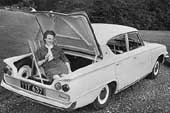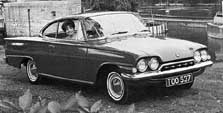![]()
Ford Consul Classic 315 1961 - 63
 The
Classic, launched in May 61,
was intended to fill the gap between Anglia and Consul. It wasn't intended
for a long producing life, the Cortina was already in a advanced state of
development, and the management of Ford decided to use short-life Kirksite
dies for pressing the bodypanels. The
Classic, launched in May 61,
was intended to fill the gap between Anglia and Consul. It wasn't intended
for a long producing life, the Cortina was already in a advanced state of
development, and the management of Ford decided to use short-life Kirksite
dies for pressing the bodypanels. |
| The engineers did not attempt to
save weight of the body-structure which made the Classic and later the
Capri to real heavy-weight cars.The Classic came
first with the 1340 ccm engine, used the same block, valves, sprigs and
pistons as the Anglia (105E), but the stroke was increased to 65,07 mm.
The 4-speed gearbox offered the option of a column gearchange in addition
to the floor change. The engineers had some experiments with a independent
rear suspension, but they decided to use the well known irs design as a
tribute to the cost of development.
The quadruple headlights appeared first on the Classic in the family car class. The press said: " ... good enough for a much faster car..." The largest size of boot on any medium sized car was reason enough to make a press photo with a woman sitting in a deckchair in the open boot of a classic. Disk breaks on the McPherson front suspension were standardised, but the servo was fitted to the later Capri GT only. The DeLuxe versions came with bright metal interior and exterior trim, including a five-star motif across the front grille, combined door pulls and armrests, two tone PVC upholstery, optional column gearchange, floorcarpet, passenger sunvisor, rear ashtray and cigar lighter, windscreen washer, headlight flasher, twin horns, coat hooks and front door courtesy light. Hide / PVC-trim, heater, demister, and whitewalltires were extra! The robust construction of the Classic had resulted in a kerb weight of 2095lb. Combined with the high final drive ratio led to complaints that the engine lacked flexibility. In August 1962 the Classic appeared with the new 1500 ccm engine. The new unit hat five mainbearings instead of three, had 10% more torque. The result was 3 mph more top speed. the crankshaft was now solid rather than the former used cored-out, since the Ford engineers now admit that the advantages of a cored-out are more theoretical than real. Another improvement was that the gearbox came with synchromesh on all four speeds. But by now the advent of the Cortina had rendered the Classic rather superfluous and only 27000 units of the new model had been produced by the time production ended just over a year later.
|
Classic 1340 ccm 1961-62
Produced
Standard two door: June 1961 - August 1962
Standard four door: April 1961 - July 1962
DeLuxe two door: April 1961 - July 1962
DeLuxe four door: April 1961 - August 1962
Specification
Engine: in-line 1340ccm four cylinder ohv
Bore x Stroke: 80,96 x 65,07 mm
Max. Power: 56,5 bhp at 5000 rpm
Transmission: 4-Speed
Chassis: pressed steel monocoque
Suspension: McPerson strut front, semi-ellipic rear
Wheelbase: 99 in (2515 mm)
Track: 49,5 in (1257 mm)
Length: 170.8i n (4338 mm)
Breaks: 4-wheel hydraulic , disk front / drum rear
Max. speed: 78 mph (126 km/h)
Classic 1500 ccm 1962 - 63
Produced
July 28, 1962 - September 1963
Specification
as the Classic 1340 ccm except:
Engine: in-line 1500 ccm four cylinder ohv
Bore x Stroke: 80,97 x 72,82 mm
Max. Power: 59,5 bhp at 4600 rpm
Max. speed: 82 mph (132 km/h)
Ford Consul Capri 335
 The Capri was the first European
Ford with that name. It was aimed squarely at the export market and the
first few weeks' -production was for overseas sale only. The Capri made
it's show debut on the Frankfurt Automobil Ausstellung in September 1961
on a Stand full of Ford-Germany Taunuses. On the opening day 86 Capris
were sold and the marketing men were talking optimistically of sales of
2000 units during 1962. Well, from the waist down, the Capri was identical
to the two door Classic apart from minor changes to the doors to
accommodate a different type of winding mechanism. The Capri was the first European
Ford with that name. It was aimed squarely at the export market and the
first few weeks' -production was for overseas sale only. The Capri made
it's show debut on the Frankfurt Automobil Ausstellung in September 1961
on a Stand full of Ford-Germany Taunuses. On the opening day 86 Capris
were sold and the marketing men were talking optimistically of sales of
2000 units during 1962. Well, from the waist down, the Capri was identical
to the two door Classic apart from minor changes to the doors to
accommodate a different type of winding mechanism. |
| The tremendous
difference in appearance was the replacing of the saloon roof section with
a streamlined coupé top, whose rear window was raked 40 deg. from the
horizontal; the lower roof line reduced overall height by 2 in.
The Capri had better front seats than the Classic, but the nominal rear seats in the shape of a thinly padded shelf more suited to carriage of luggage since there was restricted headroom. Crushions to cover this platform were optional extras which only slightly mitigated the medicore comfort complained of by road testers. The semi-elliptic rear side windows gave a foretaste of the style that was to distinguish a later car called Capri and wound down flush with the rear sill to create a pillarless coupé. Other interior trim differences giving the Capri the edge over the Classic. A fitted nylon carpet and white sequinned PVC headlining were fitted as standard. Driving controls and instruments were identical to those of the Classic but the steering wheel was lowered by 0.5 in. The reduced top-hamper improved the handling and road-testers remarked that the Capri "is not much affected by cross-winds". In common with the Classic, the Capri gained the new 1500 ccm engine in July 1962 to counteract criticism of poor low-speed flexibility. On February 21, 1963, a new performance variant of the Capri, the GT, was unveiled in response to an important movement to get "more fun into motoring, more liveliness, more performance". Modifications to the engine - fitting a twin-choke Weber carburettor, four branch outlet and modified inlet manifold, larger exhaust valves, and a Keith Duckworth designed high-lift camshaft - raised the power by over 30 per cent, torque by 12 per cent and increased the useful rev band by 500 rpm. A remote floor shift was fitted and a supplementary instrument panel carried rev-counter, ammeter and oil pressure gauge. The front discs were now servo assisted so that harder pad material could be used. At only £ 115 more than the standard model, the Capri GT offered excellent value for money and remained in production after the standard Capri had been withdrawn, though the final year's sales of only 412 units hardly seemed worth the efforts.
|
Capri 1340 ccm 1961-62
Produced
July 1961 - August 1962
Specification
Engine: in-line 1340ccm four cylinder ohv
Bore x Stroke: 80,96 x 65,07 mm
Max. Power: 56,5 bhp at 5000 rpm
Transmission: 4-Speed
Chassis: pressed steel monocoque
Suspension: McPerson strut front, semi-ellipic rear
Wheelbase: 99 in (2515 mm)
Track: 49,5 in (1257 mm)
Length: 170.8i n (4338 mm)
Breaks: 4-wheel hydraulic , disk front / drum rear
Max. speed: 82,5 mph (133 km/h)
Classic 1500 ccm 1962-64
Produced
Capri: July 1962 - September 1963
Capri GT: February 1963 - July 1964
Specification
as the Capri 1340 ccm except:
Engine: in-line 1500 ccm four cylinder ohv
Bore x Stroke: 80,97 x 72,82 mm
Max. Power: 59,5 bhp at 4600 rpm
Max. Power: 78 bhp at 5200 rpm (GT)
Max. speed: 87 mph (140 km/h)
Max. speed: 95 mph (153 km/h) (GT)
Source: D. Burgess-Wise
© Cersten Richter 1998, 1999
Last update: 20.10.04